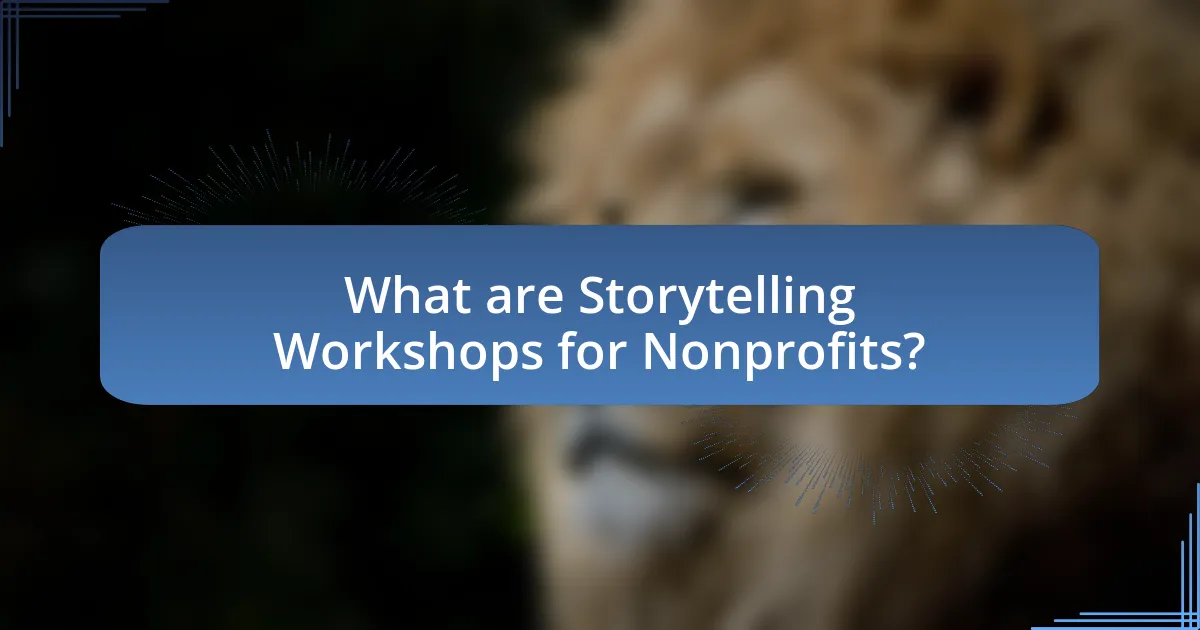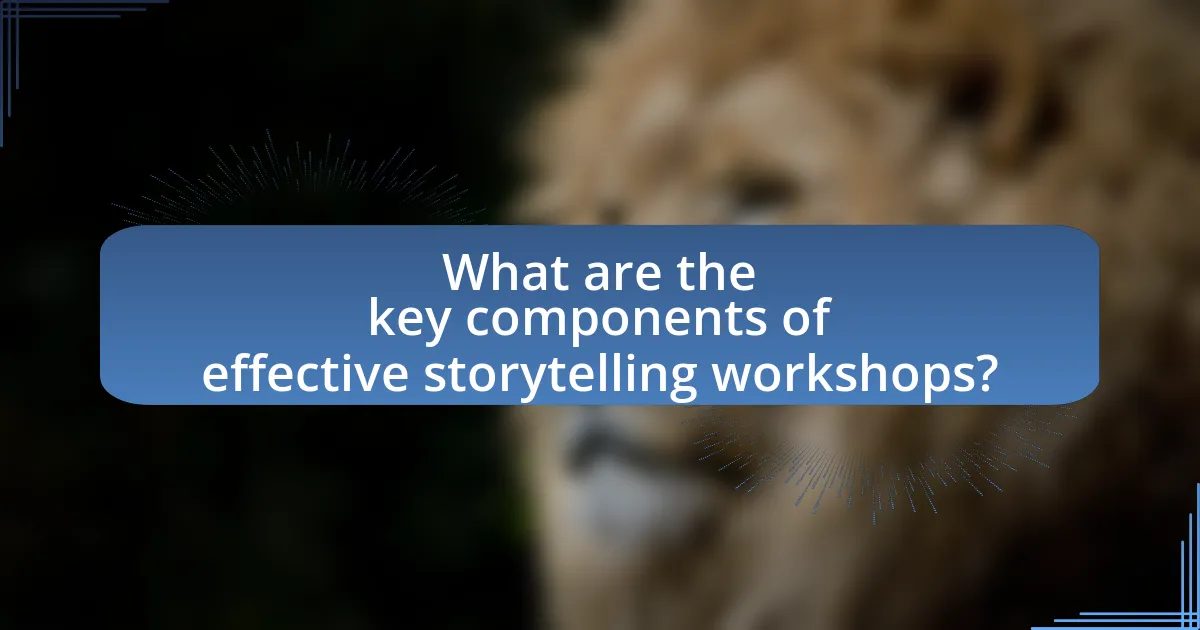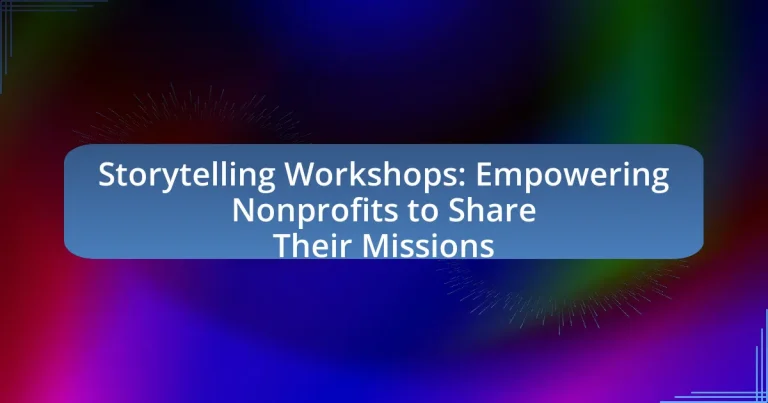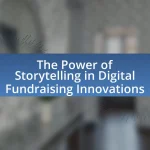Storytelling workshops for nonprofits are structured sessions aimed at enhancing organizations’ abilities to communicate their missions and impacts through effective narrative techniques. These workshops empower participants by teaching them how to craft compelling stories that resonate with audiences, ultimately increasing donor engagement and retention. Key components of successful workshops include clear objectives, interactive activities, and feedback mechanisms, which collectively foster essential skills such as effective communication and emotional engagement. By mastering storytelling techniques, nonprofits can overcome challenges in sharing their missions, attract funding, and drive greater social change.

What are Storytelling Workshops for Nonprofits?
Storytelling workshops for nonprofits are structured sessions designed to help organizations effectively communicate their missions and impact through narrative techniques. These workshops typically focus on teaching participants how to craft compelling stories that resonate with their audience, thereby enhancing engagement and support for their causes. Research indicates that storytelling can significantly increase donor retention and engagement, as narratives create emotional connections that statistics alone cannot achieve.
How do storytelling workshops empower nonprofits?
Storytelling workshops empower nonprofits by enhancing their ability to communicate their mission and impact effectively. These workshops provide training in narrative techniques, enabling organizations to craft compelling stories that resonate with their audience. Research indicates that storytelling can increase engagement and donations; for instance, a study by the Stanford Graduate School of Business found that stories are 22 times more memorable than facts alone. By mastering storytelling, nonprofits can build stronger connections with supporters, attract funding, and raise awareness about their causes.
What skills do participants gain from storytelling workshops?
Participants in storytelling workshops gain essential skills such as effective communication, narrative development, and audience engagement. These skills enable individuals to articulate their messages clearly, structure their stories compellingly, and connect emotionally with their audience. Research indicates that storytelling enhances critical thinking and creativity, as participants learn to craft narratives that resonate with listeners, making their missions more impactful. Additionally, storytelling workshops often foster collaboration and feedback, further refining participants’ abilities to convey their ideas effectively.
How do storytelling workshops enhance nonprofit missions?
Storytelling workshops enhance nonprofit missions by equipping organizations with the skills to effectively communicate their impact and engage their audience. These workshops teach participants how to craft compelling narratives that resonate emotionally, thereby increasing donor engagement and community support. Research indicates that storytelling can improve fundraising outcomes; for instance, a study by the Stanford Graduate School of Business found that narratives can increase donations by up to 30% when they connect emotionally with the audience. By mastering storytelling techniques, nonprofits can articulate their mission more clearly, foster deeper connections with stakeholders, and ultimately drive greater social change.
Why are storytelling workshops important for nonprofits?
Storytelling workshops are important for nonprofits because they enhance the organization’s ability to communicate its mission effectively. These workshops equip nonprofit staff and volunteers with the skills to craft compelling narratives that resonate with their audience, fostering emotional connections and engagement. Research indicates that storytelling can increase donor retention rates by up to 50%, as narratives create a sense of belonging and urgency among supporters. By mastering storytelling techniques, nonprofits can better articulate their impact, attract funding, and mobilize community support, ultimately leading to greater success in achieving their goals.
What challenges do nonprofits face in sharing their missions?
Nonprofits face several challenges in sharing their missions, primarily due to limited resources, lack of effective communication strategies, and audience engagement difficulties. Limited financial and human resources restrict their ability to invest in marketing and outreach efforts, which are essential for mission visibility. Additionally, many nonprofits struggle to articulate their missions in a compelling way that resonates with diverse audiences, leading to ineffective messaging. Research indicates that 70% of nonprofits report challenges in effectively communicating their impact, which hampers their ability to attract support and funding. Furthermore, engaging audiences through storytelling can be complex, as nonprofits must navigate varying preferences and interests among potential supporters.
How can storytelling address these challenges?
Storytelling can address challenges faced by nonprofits by enhancing their ability to communicate their missions effectively. By utilizing narrative techniques, nonprofits can create emotional connections with their audiences, making their messages more relatable and impactful. Research indicates that stories can increase engagement and retention of information; for instance, a study by the NeuroLeadership Institute found that storytelling can improve recall by up to 22 times compared to facts alone. This ability to resonate with audiences helps nonprofits overcome barriers such as donor fatigue and lack of awareness, ultimately driving support and engagement for their causes.

What are the key components of effective storytelling workshops?
The key components of effective storytelling workshops include clear objectives, participant engagement, structured frameworks, and feedback mechanisms. Clear objectives guide the workshop’s focus, ensuring that participants understand the purpose and desired outcomes. Participant engagement fosters a collaborative environment, encouraging sharing and interaction, which enhances learning. Structured frameworks provide participants with tools and techniques for crafting compelling narratives, such as the hero’s journey or the three-act structure. Feedback mechanisms allow for constructive critique, helping participants refine their stories and improve their storytelling skills. These components collectively enhance the effectiveness of storytelling workshops, enabling nonprofits to articulate their missions more powerfully.
What methodologies are used in storytelling workshops?
Storytelling workshops utilize various methodologies, including narrative structure analysis, participatory storytelling, and improvisational techniques. Narrative structure analysis helps participants understand the components of effective stories, such as character development and plot progression. Participatory storytelling encourages collaboration among participants, allowing them to share personal experiences and insights, which fosters a sense of community. Improvisational techniques enhance creativity and adaptability, enabling storytellers to respond dynamically to their audience. These methodologies are supported by research indicating that structured storytelling can significantly improve communication skills and engagement in nonprofit contexts.
How do interactive activities contribute to learning in workshops?
Interactive activities enhance learning in workshops by promoting engagement and facilitating hands-on experience. These activities encourage participants to actively participate, which leads to better retention of information and skills. Research indicates that experiential learning, such as role-playing or group discussions, significantly improves understanding and application of concepts. For instance, a study by Kolb (1984) on experiential learning emphasizes that learning is most effective when individuals can reflect on their experiences and apply them in real-world scenarios. This approach is particularly beneficial in storytelling workshops, where nonprofits can practice and refine their narrative techniques through interactive exercises, ultimately empowering them to communicate their missions more effectively.
What role does feedback play in the workshop process?
Feedback plays a crucial role in the workshop process by enhancing participant learning and improving storytelling skills. It provides immediate insights into the effectiveness of narratives, allowing participants to refine their messages and delivery. Research indicates that constructive feedback can increase engagement and retention of information, as seen in studies where participants who received feedback demonstrated a 20% improvement in their storytelling abilities compared to those who did not. This iterative process of receiving and applying feedback fosters a collaborative environment, ultimately empowering nonprofits to communicate their missions more effectively.
What types of storytelling techniques are taught?
Storytelling workshops for nonprofits teach various techniques, including narrative structure, character development, emotional engagement, and the use of visuals. Narrative structure helps participants organize their stories effectively, while character development focuses on creating relatable figures that resonate with audiences. Emotional engagement techniques are essential for connecting with listeners on a deeper level, and the use of visuals enhances storytelling by providing context and capturing attention. These techniques are critical for nonprofits to effectively communicate their missions and impact.
How can nonprofits use narrative structures effectively?
Nonprofits can use narrative structures effectively by crafting compelling stories that resonate emotionally with their audience. By employing a clear beginning, middle, and end, nonprofits can engage supporters, illustrate their mission, and highlight the impact of their work. For instance, a study by the Stanford Social Innovation Review found that storytelling can increase donor engagement by up to 50%, demonstrating the power of narrative in fostering connections and motivating action. This structured approach allows nonprofits to convey complex information in an accessible manner, making their message memorable and persuasive.
What are the best practices for crafting compelling stories?
The best practices for crafting compelling stories include understanding your audience, creating a strong narrative arc, and incorporating emotional elements. Understanding your audience allows storytellers to tailor their message to resonate with specific groups, enhancing engagement. A strong narrative arc, which typically includes a clear beginning, middle, and end, helps maintain interest and provides structure. Incorporating emotional elements, such as personal anecdotes or relatable challenges, fosters a connection between the storyteller and the audience, making the story more impactful. Research indicates that stories with emotional resonance are more memorable and persuasive, as demonstrated in a study by Paul Zak, which found that narratives that evoke emotions can lead to increased empathy and action among listeners.

How can nonprofits implement storytelling workshops successfully?
Nonprofits can implement storytelling workshops successfully by clearly defining their objectives and tailoring the content to their audience. Establishing specific goals, such as enhancing donor engagement or improving community outreach, allows nonprofits to focus their workshops effectively. Additionally, utilizing experienced facilitators who understand both storytelling techniques and the nonprofit’s mission can enhance the learning experience. Research indicates that organizations that incorporate storytelling into their communication strategies see a 30% increase in donor retention rates, demonstrating the effectiveness of this approach. By providing participants with practical tools and opportunities for hands-on practice, nonprofits can ensure that attendees leave with actionable skills to share their stories compellingly.
What steps should nonprofits take to organize a storytelling workshop?
Nonprofits should take the following steps to organize a storytelling workshop: first, identify the target audience and define the workshop’s objectives. This ensures that the content is relevant and tailored to the participants’ needs. Next, select a suitable venue that accommodates the expected number of attendees and provides a conducive environment for storytelling. Then, develop a structured agenda that includes interactive activities, such as group discussions and practice sessions, to engage participants effectively.
Additionally, nonprofits should recruit experienced facilitators who can guide the workshop and provide valuable feedback. Promoting the workshop through various channels, such as social media and community partnerships, is crucial to attract participants. Finally, gather feedback after the workshop to assess its impact and identify areas for improvement, ensuring future workshops are even more effective. These steps are essential for creating a successful storytelling workshop that empowers nonprofits to share their missions effectively.
How can nonprofits identify their target audience for workshops?
Nonprofits can identify their target audience for workshops by conducting thorough market research and analyzing community needs. This involves gathering demographic data, assessing local interests, and engaging with potential participants through surveys or focus groups. For instance, a study by the Nonprofit Research Collaborative found that 70% of nonprofits that utilized community feedback effectively tailored their programs to meet audience needs, resulting in higher participation rates. By leveraging these methods, nonprofits can ensure their workshops resonate with the intended audience, ultimately enhancing their mission impact.
What resources are needed to conduct a successful workshop?
To conduct a successful workshop, essential resources include a suitable venue, materials for participants, skilled facilitators, and technology for presentations. A suitable venue provides a comfortable environment conducive to learning and engagement, while materials such as handouts, worksheets, and writing tools facilitate participant interaction and learning. Skilled facilitators are crucial as they guide discussions and activities, ensuring that the workshop objectives are met effectively. Technology, including projectors, audio equipment, and internet access, enhances the delivery of content and supports interactive elements. These resources collectively contribute to a productive and impactful workshop experience, as evidenced by numerous successful workshops that prioritize these elements to achieve their goals.
What are common pitfalls to avoid in storytelling workshops?
Common pitfalls to avoid in storytelling workshops include lack of clear objectives, insufficient participant engagement, and neglecting the audience’s needs. Clear objectives guide the workshop’s direction and outcomes; without them, participants may feel lost or unmotivated. Engaging participants is crucial, as passive involvement can lead to disinterest and ineffective storytelling. Additionally, failing to consider the audience’s preferences and expectations can result in stories that do not resonate, diminishing the impact of the workshop. These pitfalls can hinder the effectiveness of storytelling workshops aimed at empowering nonprofits to share their missions.
How can nonprofits ensure engagement during workshops?
Nonprofits can ensure engagement during workshops by incorporating interactive elements such as group discussions, hands-on activities, and storytelling techniques. Research indicates that interactive learning increases retention and participation; for instance, a study by the National Training Laboratories found that people retain 75% of what they learn through practice and teaching others. By facilitating small group interactions and encouraging participants to share their own stories, nonprofits can create a more dynamic and inclusive environment that fosters connection and engagement.
What strategies can be used to measure the success of workshops?
To measure the success of workshops, strategies such as participant feedback surveys, pre- and post-workshop assessments, and tracking engagement metrics can be employed. Participant feedback surveys provide direct insights into attendees’ perceptions and learning outcomes, allowing facilitators to gauge satisfaction and areas for improvement. Pre- and post-workshop assessments can quantitatively measure knowledge or skill acquisition, demonstrating the effectiveness of the workshop content. Tracking engagement metrics, such as attendance rates and participation levels during the workshop, offers additional data on the workshop’s reach and impact. These strategies collectively provide a comprehensive evaluation of workshop success, ensuring that the objectives of storytelling workshops for nonprofits are met effectively.
What practical tips can nonprofits use to enhance their storytelling skills?
Nonprofits can enhance their storytelling skills by focusing on clarity, emotional connection, and audience engagement. Clarity involves using simple language and a structured narrative to convey the mission effectively, which helps the audience understand the core message. Emotional connection can be achieved by sharing personal stories of individuals impacted by the nonprofit’s work, as research shows that emotional storytelling increases audience retention and empathy. Audience engagement can be fostered through interactive elements, such as asking questions or encouraging feedback during presentations, which has been shown to improve the overall effectiveness of storytelling.


